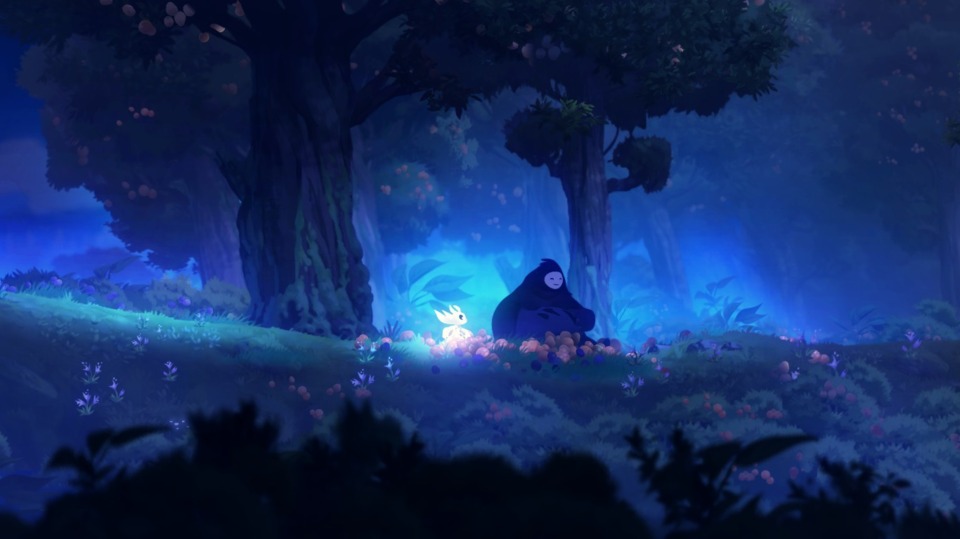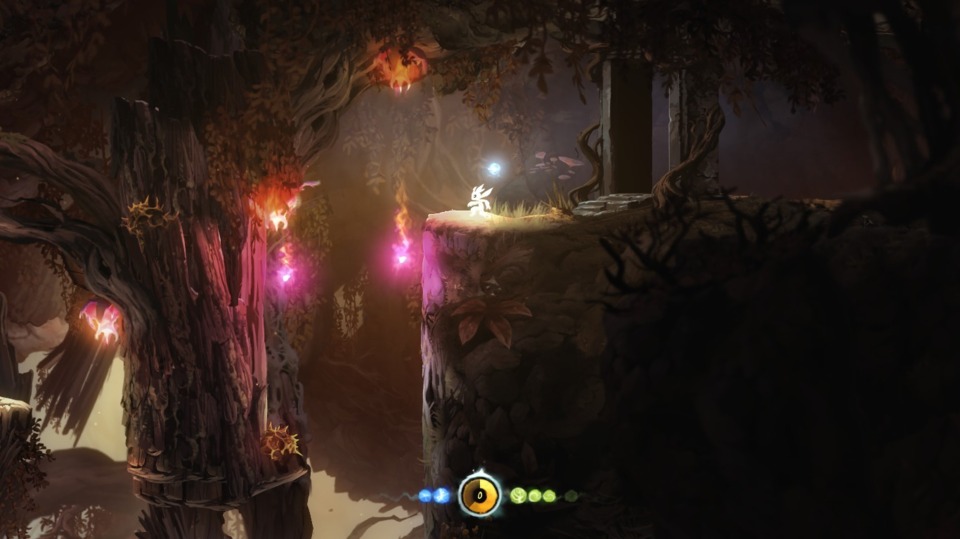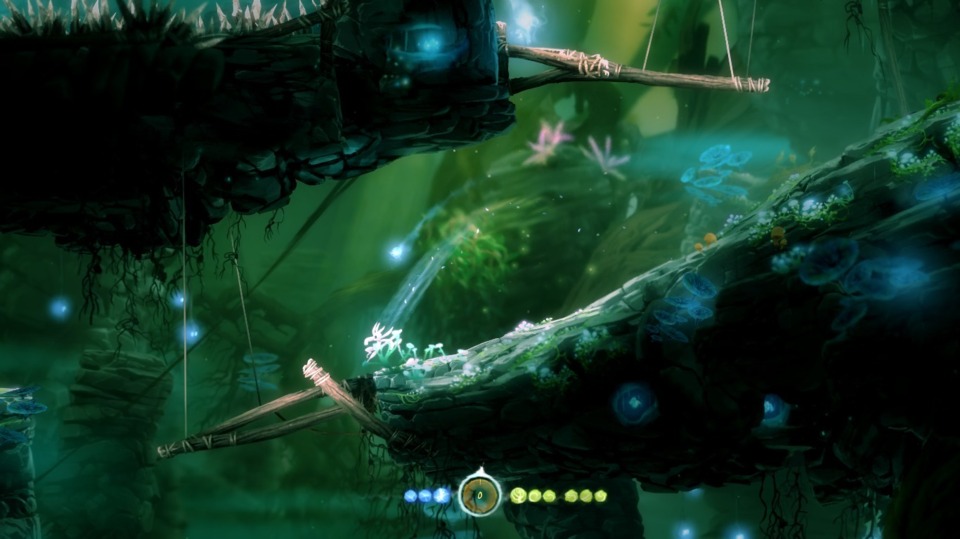Indie Game of the Week 03: Ori and the Blind Forest
By Mento 7 Comments

There's no denying that I have a soft spot for SpaceWhippers, going so far as to make up a new name for them that has yet nor will ever catch on. At the end of last year I mainlined some of the more significant recent genre entries: Axiom Verge, Headlander, Momodora: Reverie Under the Moonlight and a revisit of the stellar Castlevania: Aria of Sorrow. One of those abandoned genres like survival horror that the Indie market has embraced in lieu of continued support from major studios and the "AAA" market, who are far more interested in the avaricious gains to be found in open-world and online games with plentiful microtransaction support, SpaceWhippers are often an exercise in elegant level design and an attempt to inject a world with a developing sense of familiarity by having players discover new areas as they continue to track and backtrack through the same photogenic thoroughfares. There's more to the genre than just superficial geographic concerns, of course, but when you have a game as luxuriously rendered and animated as Ori and the Blind Forest, there's a sense that the developers wanted the player to see as much of that world as possible, even if it means passing through the same picturesque copse a number of times on their way to the next required destination.
Ori is in many ways a standard SpaceWhipper. I once speciously attempted to define the SpaceWhipper (back when I was still calling it by its accepted name, Metroidvania) by the three slightly older and more established genre "pillars" on which any given SpaceWhipper might stand: platforming, action (by way of a semi-elaborate combat system) and light RPG mechanics, though I perhaps forgot that light RPG mechanics can be found in almost everything. A SpaceWhipper is defined first and foremost by its exploration of an ever-expanding world made possible with the regular influx of new traversal-enabling abilities, such as high ledges prohibiting any player who has yet to acquire a double-jump, or an underwater zone impassable to those who have yet to unlock the incredible and elusive power of swimming. However, exploration for exploration's sake is rarely enough, and a SpaceWhipper's "meat" can be built from any combination of those three aforementioned genres.

The crux of Ori's gameplay and challenge is almost entirely on the platforming aspect of that triumvirate, with most of the acquired skills revolving around its little glowing hero's dexterity. While the genre-ubiquitous double-jumps, ground-pounds and wall climbs are here and accounted for, Ori does have a few extra abilities that have led to some novel platforming scenarios. The most significant of which, in my view and based on how far I am, is the "bash" ability that allows Ori to catapult himself in any direction using certain types of environmental objects as a hook. These objects can include passive lantern fixtures in the background, but also enemies and enemy projectiles. A corollary of this catapult maneuver is that it sends the object used as a launch point to fly in the opposite direction. Not only does this ability create a means of expedient motion, by quickly slingshotting from point to point, but also a creative way of dispatching enemies or quickly moving past them if your intent is to avoid combat. Eliminating creatures does net a few gains - as well as regaining health and "mana", the game has an experience point system to be spent on optional but useful abilities, like increased defense or a magnet for item drops - but these rewards can come at a cost if the player is forced into a protracted battle with a durable enemy, and it's often more efficient to just sidestep battles entirely and getting one's XP gains from collectibles instead. By creating a means to quickly whip past them, the game clearly defines itself as a platformer first and foremost with combat being a largely secondary concern. In fact, combat rarely becomes more involved than mashing the attack button and letting Ori's Navi-like buddy zap enemies with beams of light until they explode.
Presently, I'm only halfway through the game, but I've already faced some challenging situations in my quest to heal Ori's sylvan home from the red-and-purple-tinged corruption that has seized it. One such challenge occurred directly after restoring the "element of water", which quickly filled the hollow tree trunk dungeon I was in with a rushing torrent of water and forced me to quickly escape to the top of the structure by using the newly acquired bash power described above to stay one step ahead of the rising cascade. A significant element to contribute to the game's heightened difficulty is that it doesn't checkpoint like others of its genre, nor does it preserve any progress after the last time you saved. It incorporates instead a "save anywhere" system that requires the player expend some of their mana to create a save point at any time. The first few times you forget to save after a difficult platforming challenge or after ten minutes spent backtracking to sweep up suddenly-accessible collectibles and lose that progress is enough to impart the importance of saving regularly. Fortunately, as you gain more mana reserves, the expenditure of a new save point becomes less and less costly. It then boils down to the irritation of simply forgetting to do it regularly; still, if it was a choice between this system and the static save points of the genre's 16-bit/32-bit forebears, I appreciate being able to set down a save point right before a gauntlet of spikes and/or instant-kill timed beams to push past. It is, essentially, a modern save state system with a handful of caveats and limitations - it won't let you save on "unstable ground" (such as a crumbling platform) or "a dangerous area" (in the path of a laser beam, even if that beam is blocked) or anywhere where an enemy is in proximity. Unfortunately, in the scenario outlined above with a minutes-long rush to stay ahead of a fatal flood, there are no safe areas that qualify between triggering the event in question and when the sequence is completed.

Alas, the game's greatest difficulty is one entirely of my own creation, or more specifically one borne of poor computer performance. Because the game is so lush with its graphical presentation, with all manner of bloom effects and other system-taxing audiovisual touches, the game runs at a framerate that fluctuates wildly depending on how much is on the screen. When it starts to lag heavily, so too do my controller inputs, leading to situations where an already challenging game becomes magnitudes more so as the game refuses to accept some or all the stages of a multi-button "jump to double-jump to wall-jump to double jump" process. It's happened just enough times to be frustrating but not often enough to convince me to put the game away until I have something that can run it more smoothly. Yet, as I get deeper into the game and face greater challenges that require longer series of accurate inputs to survive, I'm sure I'll be revisiting this dilemma a few more times.
Presently, though, I think this is a fantastic game of its genre, and not just courtesy of its top-notch presentation. It reminds me in more than a few ways of Dust: An Elysian Tail beyond the visual similarity of its titular hero Ori and Dust's vaguely cat-like sidekick Fidget. That game has a remarkable storybook presentation, but managed to outdo it with its concisely controlled and in-depth platforming and combat. Likewise, Ori might dazzle those shopping around on digital distribution marketplaces with just how gorgeous it looks, but there's a solid and quite demanding platformer underneath the pulchritude. My one gripe was that the game prohibits acquiring 100% because certain set-piece areas become closed off - a cardinal sin for SpaceWhippers - but I discovered while playing that the Definitive Edition not only fixes that issue, but adds a convenient teleport system that was somehow missing from the original. Besides a distinctive save system that takes some getting used to and the struggles involved in trying to get the game to run smoothly on what might as well be a Tandy from the 1980s, I can't say it's put a foot wrong yet.
(Special thanks to my buddy TeflonBilly for the game! Well, the 75% off voucher for the game, at least.)

Rating: 5 out of 5.
| < Back to 02: Refunct | > Forward to 04: Shardlight |
